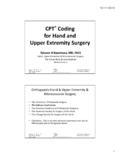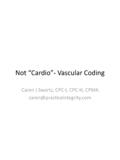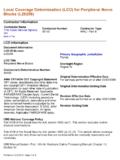Transcription of ABDOMEN IMAGING GUIDELINES - eviCore
1 MedSolutions, Inc. This tool addresses common symptoms and symptom complexes. IMAGING requests for patients with atypical Clinical Decision Support Tool symptoms or clinical presentations that are not specifically addressed will require physician review. Diagnostic Strategies Consultation with the referring physician, specialist and/or patient's Primary Care Physician (PCP) may provide additional insight. ABDOMEN IMAGING GUIDELINES . Version ; Effective 02-16-2015. MedSolutions, Inc. Clinical Decision Support Tool for Advanced Diagnostic IMAGING Common symptoms and symptom complexes are addressed by this tool. IMAGING requests for patients with atypical symptoms or clinical presentations that are not specifically addressed will require physician review. Consultation with the referring physician may provide additional insight.
2 This version incorporates MSI accepted revisions prior to 12/31/14. CPT (Current Procedural Terminology) is a registered trademark of the American Medical Association (AMA). CPT five digit codes, nomenclature and other data are copyright 2015 American Medical Association. All Rights Reserved. No fee schedules, basic units, relative values or related listings are included in the CPT book. AMA does not directly or indirectly practice medicine or dispense medical services. AMA assumes no liability for the data contained herein or not contained herein. 2015 MedSolutions, Inc. ABDOMEN IMAGING GUIDELINES ABDOMEN IMAGING GUIDELINES . ABDOMEN IMAGING GUIDELINES Abbreviations 3. AB-1~General GUIDELINES 4. AB-2~Abdominal Pain 10. AB-3~Abdominal Sepsis 15. AB-4~Flank Pain, Rule Out Renal Stone 16. AB-5~Gastroenteritis 18.
3 AB-6~Mesenteric Colonic Ischemia 19. AB-7~Post-Operative Pain Within 60 Days Following Abdominal Surgery 21. AB-8~Abdominal Lymphadenopathy 22. AB-9~Bariatric Surgery 22. AB-10~Blunt Abdominal Trauma 23. AB-11~Gaucher's Disease and Hemochromatosis 24. AB-12~Hernias 25. AB-13~Abdominal Mass 27. AB-14~Lower Extremity Edema 28. AB-15~Zollinger-Ellison Syndrome (ZES) 28. AB-16~Adrenal Cortical Lesions 29. AB-17~Aneurysms Follow Up of Known Anuerysms and Pre-Operative Evaluation 32. AB-18~ Aneurysms Post Endovascular or Open Aortic Repair 35. AB-19~Aortic Dissection and IMAGING for Other Aortic Conditions 36. AB-20~Bowel Obstruction 37. AB-21~Diarrhea Constipation and Irritable Bowel 38. AB-22~GI Bleeding 40. AB-23~Imflammatory Bowel Disease, Rule Out Crohn's Disease or Ulcerative Colitis 41. AB-24~Celiac Disease (Sprue) 42.
4 AB-25~CT Colonography (CTC) 43. AB-26~Cirrhosis and Liver Screening for Hepatocellular Carcinoma (HCC) 44. AB-27~MR Cholangiopancreatography (MRCP) 46. AB-28~Jaundice 48. AB-29~Liver Lesion Characterization 49. AB-30~Elevated Liver Function (LFT)Levels 51. AB-31~Pancreatic Lesion 52. AB-32~Pancreatic Pseudocysts 53. AB-33~Pancreatitis 54 AB-38~Polycystic Kidney Disease 62. AB-34~Spleen 56 AB-39~Hematuria 63. AB-35~Indeterminate Renal Lesion 58 AB-40~Urinary Tract Infection 64. AB-36~Renal Failure 60 AB-41~Patent Urachus 66. AB-37~Renovascular Hypertension 61 AB-42~Transplant 67. Version ; Effective 02-16-2015 ABDOMEN RETURN Page 2 of 69. ABBREVIATIONS for ABDOMEN IMAGING GUIDELINES . AAA abdominal aortic aneurysm ACE angiotensin-converting enzyme ACTH adrenocorticotropic hormone AFP alpha-fetoprotein ALT alanine aminotransferase AST aspirate aminotransferase BEIR Biological Effects of Ionizing Radiation BUN blood urea nitrogen CNS central nervous system CT computed tomography CTA computed tomography angiography CTC computed tomography colonography (aka: virtual colonoscopy).
5 DVT deep vein thrombosis ERCP endoscopic retrograde cholangiopancreatography FNH focal nodular hyperplasia GFR glomerular filtration rate GGT gamma glutamyl transferase GI gastrointestinal HCC hepatocellular carcinoma HCPCS Healthcare Common Procedural Coding System (commonly pronounced: hix pix ). HU Hounsfield units IAA iliac artery aneurysm IV intravenous KUB kidneys, ureters, bladder (plain frontal supine abdominal radiograph). LFT liver function tests MRCP magnetic resonance cholangiopancreatography MRA magnetic resonance angiography MRI magnetic resonance IMAGING mSv millisievert NAFLD nonalcoholic fatty liver disease PA posteroanterior projection PET positron emission tomography RAS renal artery stenosis RBC red blood cell SBFT small bowel follow through SPECT single photon emission computed tomography VC virtual colonoscopy (CT colonography).
6 PFT pulmonary function tests WBC white blood cell ZES Zollinger-Ellison Syndrome Version ; Effective 02-16-2015 ABDOMEN RETURN Page 3 of 69. ABDOMEN IMAGING GUIDELINES . AB-1~GENERAL GUIDELINES . AB-1 General GUIDELINES Overview 5. CT IMAGING 6. MR IMAGING 7. MR Enterography Coding Notes 7. Ultrasound 7. Abdominal Ultrasound 8. Retroperitoneal Ultrasound 8. CT-, MR-, Ultrasound-guided Procedures 9. Special Considerations 9. Version ; Effective 02-16-2015 ABDOMEN RETURN Page 4 of 69. ABDOMEN IMAGING GUIDELINES . AB-1~GENERAL GUIDELINES . Overview A current clinical evaluation (within 60 days) is required before advanced IMAGING can be considered. The clinical evaluation may include a relevant history and physical examination, appropriate laboratory studies, and non-advanced IMAGING modalities such as plain x-ray or ultrasound.
7 Other meaningful contact (telephone call, electronic mail or messaging) by an established patient can substitute for a face-to-face clinical evaluation. GI Specialist evaluations can be helpful, particularly in determining mesenteric/colonic ischemia, diarrhea/constipation, irritable bowel syndrome, or need for MRCP. Conservative treatment for abdominal pain can include (list is not exhaustive): o Anti-secretory or H. Pylori medications o Non-steroidal or opiate analgesia o Plain abdominal radiography o Diet modification o Pro- or anti-motility agents Abdominal IMAGING begins at the diaphragm and extends to the umbilicus or iliac crest. Pelvic IMAGING begins at the iliac crest and extends to the pubis. Clinical concerns at the dividing line can be providers' choice ( ABDOMEN and pelvis;. ABDOMEN or pelvis).
8 Version ; Effective 02-16-2015 ABDOMEN RETURN Page 5 of 69. CT IMAGING CT IMAGING is a more generalized modality. Abdominal CT is usually performed with contrast (CPT 74160): o Oral contrast has no relation to the IV contrast administered. o Exceptions are noted in these GUIDELINES , and include: Abdominal CT with contrast (CPT 74160) or without and with contrast (CPT 74170) with suspicion of a solid organ lesion (liver, kidney, pancreas, spleen). Abdominal CT without contrast (CPT 74150) or ABDOMEN and Pelvis CT. (CPT 74176) if there is renal insufficiency/failure, or a documented allergy to contrast. It can also be considered for diabetics or the very elderly. o ABDOMEN with Pelvis CT, usually with contrast (CPT 74177), should be considered when signs or symptoms are generalized or lower quadrant ABDOMEN or pelvic.
9 O CT Enterography (CPT 74177) combines CT IMAGING with large volumes of ingested neutral bowel contrast material to allow visualization of the small bowel Usually, only 2D reformatting is used (coronal reformatted images). If the 3D rendering codes are requested (CPT 76376 or CPT 76377), then the final radiology report should be obtained first to verify that true 3D rendering was performed. Also see AB-23~Inflammatory Bowel Disease o CT Enteroclysis A tube is placed through the nose or mouth and advanced into the duodenum or jejunum. Bowel contrast material is infused through the tube and CT IMAGING is performed either with or without intravenous contrast. CT enteroclysis is used to allow visualization of the small bowel wall and lumen. CT enteroclysis may allow better or more consistent distention of the small bowel than CT enterography.
10 Report by assigning: CPT 74176 or CPT 74177. Usually, only 2D reformatting is used (coronal reformatted images). The final radiology report should be obtained first to verify that true 3D. rendering was performed when 3D rendering codes are requested (CPT 76376. or CPT 76377). o Also see: AB-23~Inflammatory Bowel Disease Version ; Effective 02-16-2015 ABDOMEN RETURN Page 6 of 69. MR IMAGING MRI may be preferred as a more targeted study, in cases of renal failure; in patients allergic to intravenous CT contrast; and as noted in these GUIDELINES . o MRI of the ABDOMEN with contrast only is essentially never performed. If contrast is indicated, MRI ABDOMEN without and with contrast (CPT 74183) should be performed. o For pregnant women ultrasound or MRI without contrast should be used to avoid radiation exposure.





